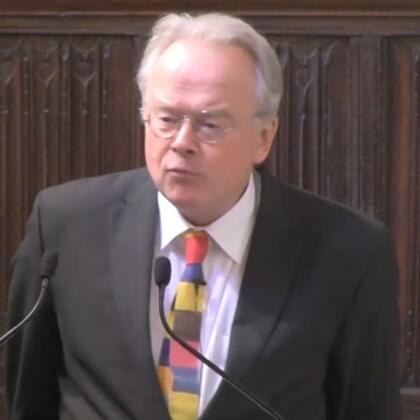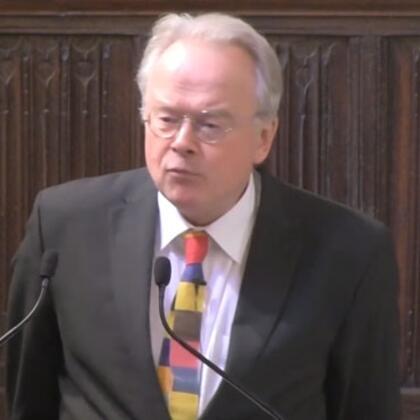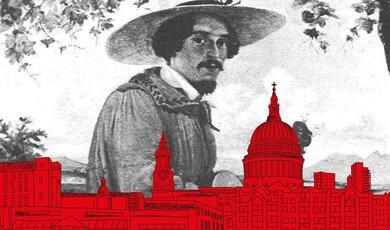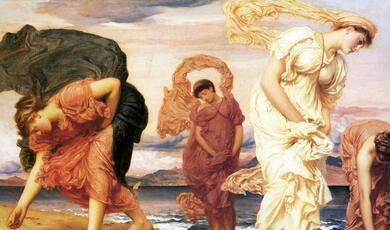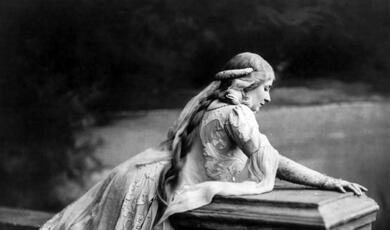Beyond 'Surprise or Satisfy' a New Theory of Performance
Share
- Details
- Transcript
- Audio
- Downloads
- Extra Reading
That the key to an audience's attention is to fulfil or frustrate its expectations is a theory first hinted at in 1752 by Charles Avison.
David Owen Norris fleshes it out with examples, including the blind-folded cellist and an occasion when Sir Peter Pears sang Eugene Onegin. And he takes the theory further by gazing into a looking-glass.
Download Transcript
14 May 2015
Beyond ‘Surprise or Satisfy’ a New Theory of Performance
Professor David Owen Norris
SLIDE 2
In the spelling of such words as Baptize, Recognise, Realize and Surprise, I follow the orthography of Dr Johnson’s Dictionary, which uses S or Z according to the word’s derivation from Latin or Old French.
Eleven knocks
30 years ago, 90’ prog for BBC2 on performance, Brendel didn’t care what audiences think.
Last week, masterclass student – what do you want to happen if you play in public? – ‘have some effect on the audience’. I agree.
What effects are available?
SLIDE 3 – SorS – travelled round the world and quoted back at me.
Avison described a third reaction back in 1752.
[Disgust & Disappointment]
SLIDE 4 - ‘….our disgust, or weariness of attention, will be found in proportion to the beauties of the author so abused. And just thus it fares with an injudicious performance of a fine musical composition’.
Charles Avison 1752
And he had something to say about Surprise too, though his timidity may explain his current reputation.
SLIDE 5 - ‘As it is safer to aim at pleasing than surprising, especially in the musical art, I flatter myself I shall be in less hazard of disappointing …’
Charles Avison
SLIDE 6
Expectation – which depends on Conventions – of concerts, for example
Horowitz concert – they were listening to HOROWITZ rather than the sounds or even the music. (Never forget Sir Thomas!)
SLIDE 7 Cartoon
SLIDE 8
Expectations of Repertoire – programme notes – a public experiment – you can choose when to look, and thus control how much knowledge you have, and at what point. (tell them anything? cf Lutyens)
I shall take a leaf out of Donald Rumsfeld’s book, as you’ll see.
SLIDES 9, 10, 11, 12 (25” a slide)
New Old-Music [- Quilter Goblins: 1’35 [3’25]]
MUSIC 1
Goblins from Four Country Pieces (1923) by Roger Quilter (1877-1953)
Nice to know Goblins are rural.
Roger Quilter is one of the world’s great song composers. His piano music is less well known.
I recorded this on my own Bösendorfer – Quilter Complete Piano Music (EMR CD02)
SLIDES 13, 14, 15 (45” per slide)
New New-Music – don’t know what to expect, but expect something
PB 1. God breathing. 1’50
MUSIC 2
‘The sound of God breathing’
The opening of an oratorio entitled PrayerBook
I wrote it. (EMR CD 0012)
SLIDES 16,17, 18 (40” a slide)
Old New-Music - Music for a while 1’43 [5’25] (Playlist)
MUSIC 3
A version of Purcell’s famous song Music for a while
I arranged this for my BBC Radio 4 Playlist strand
I think this approach to music is neglected
SLIDE 19
Old Old-Music in London’s concert halls any night of the week.
The Power of Anecdote (Historical context – explain the Playlist concept)
Austen 2’ Kiallmark [7’25]
Kiallmark’s Variations on Robin Adair (the only piece of music actually named in Jane Austen’s novels).
In Emma, Frank Churchill and Emma listen to Jane Fairfax playing the new piano which Frank has anonymously presented to her: the engagement between Jane and Frank is a secret. Frank’s remarks to Emma are full of double meanings as they discuss Jane’s supposed infatuation with the married Mr. Dixon. Despite the fact that Frank says: ‘She is playing Robin Adair at this moment – his favourite’, many assume that Jane was singing as well (Peter F. Alexander, for instance, in The Review of English Studies Volume XXXIX, Number 153, Pp84-86). Even in Jane Austen’s time, with drawing-room music an ordinary entertainment, it would have been ruder to converse while someone was singing than while they were merely playing. Now we have access to new volumes from Jane Austen’s music library, we see that it’s included in the collection as a piano solo. As Professor Richard Jenkyns pointed out in Jane Austen’s iPod (BBC Radio 4, January 2nd 2010), we can now understand the significance of that word ‘playing’. The verses behind Jane Fairfax’s showy piano solo would have been known to all the listeners, of course, but their hidden significance, on which Peter F. Alexander so rightly comments, was even more cunningly obscured than he suggests. The unsung chorus, to which, however, everyone knew the words, runs:
‘Yet he I loved so wellStill in my heart shall dwell
Oh, I can ne'er forget
Robin Adair’
The piano we’ll hear dates from the very year of Jane Austen’s death. It bears the signature of the composer JB Cramer – the only composer named in Austen’s novels.
MUSIC 4
This sort of Anecdotal Approach is an example of a Prism: Expectation can be refracted through a number of prisms to give the performance a particular colour. These prismatic performances have behind them the question: Do we serve composers best by presenting what we feel their music MEANT, MEANS OR COULD mean?
SLIDE 20
as Jurisprudence (JC Bach), HAYES
SLIDE 21 (Damper Levers) – explain Circumstantial approach.
SLIDES 22, 23, 24 (20” a slide)
WFPC – Hayes slow – 56” [10’40]
MUSIC 5
The slow movement of the Concerto in A by Philip Hayes (Avie CDAV0014)
It is the World’s First Piano Concerto, published in London in 1769
Hayes went on to become both Professor of Music at Oxford (in succession to his father, William) and the Fattest Man in England
Performance as Research (Mendelssohn)
SLIDE 25 – divided pedal
SLIDE 26 – inked line on soft pedal!
Rondo capriccioso – plug Sherlock Holmes book.
But here’s another aspect of my work on Mendelssohn.
SLIDES 27, 28, 29, 30, 31, 32 (30” a slide)
Mendelssohn: 4/4 3’07 [11’40]
MUSIC 6
The fourth Song without Words from Mendelssohn’s Fourth Book.
This performance demonstrates my belief that sfimplies an accent, not of force, but of placing.
And that the abbreviations dim (get quieter) and cres (get louder) imply also a slowing-down
While the ‘hairpin’ signs that technically mean the same thing imply a speeding-up.
I recorded it on Gustav Holst’s piano, in the Drawing-Room of his Birthplace in Cheltenham.
SLIDE 33
Performance as Exegesis (QM Lute Song Lilliburlero)
QM Lute Song 1’ [12’40]
The anti-Catholic satirical song that sang James II out of three kingdoms.
Queen Mary is Mary, Queen of Scots
Elgar’s mother converted to Roman Catholicism just before his birth, and he was baptized a Catholic.
MUSIC 7
Performance as Mystic Contemplation (Debussy).
SLIDE 34 – Clair de lune, with its unperformable rhythm
SLIDE 35
More mysticism: A more technical, musical, aspect of Expectation.
Blindfolded cellist. Making Shapes – I observe that Great Performers are the easiest to accompany because they do this all the time.
Professor joke
Hoffnung Concertos– revealed the role of Learning – Recognition
Left foot Moonlight.
How many knocks were there at the beginning?
NOT recognizing shapes – Stravinsky, Chopin (7s, not 11s)
Another sort of recognition – identification with presenter. ‘Is that your house?’
DVD
Mahler: 2’06 [14’50]
Drama – Recognition of selves – Visitors - How different, how very different – (but still relating it to their own society)
Sullivan – in at 2’29EARLIER. Out: After recap (=recognition!) – at 5’42 4’[18’]
SLIDES 36 – 41 SYNCHRONIZE THE SLIDES WITH THE MUSIC
MUSIC 8
Recognition can operate at a number of purely musical levels, even for those with no prior musical knowledge. We can recognise – instinctively – the acoustic imperative of this long dominant in the bass, which demands resolution ...
... to the tonic.
(Take note of this melody, so very English in its prosody, and of its perky accompaniment.)
We can recognise the achievements of virtuosity as ends in themselves, independent of their musical meaning –
Just as the discipline of counterpoint carries a recognisable authority all its own.
Now Sullivan does a wonderful thing. This new lyrical melody is, we realize at last, simply that very English melody, transformed. What is Recapitulation, so integral to musical form, but an opportunity for Recognition?
Through this gradual process of recognition, Sullivan achieves Simultaneous Surprise & Satisfaction.
Recognition can involve more than merely the presentation of archetypes, more than an appeal to history. One complicated aspect of Recognition is Recognising Ourselves. How can music manage that? How can the performer, how can the composer, hold up a mirror to the audience?
SLIDES 43 – 61 6’30 = 20” a slide
MUSIC 9
This is Elgar’s Broadwood. I’m playing Elgar’s own arrangement of The Angel’s Farewell from The Dream of Gerontius. He wrote the piece at this piano – he wrote the title on the soundboard: third one down. I play this piano very often, and sometimes, improvising on Elgar’s themes, I’ve sensed his spirit within me. I once performed the Angel’s Farewell to the patients at Broadmoor Hospital – men sedated out of all emotion, their faces a blank. And yet, when I told them that Elgar had worked in a mental hospital, their attention sharpened. I explained that the piece represented an angel saying goodbye to a soul in heaven, and they became thoughtful: death, alas, they know all too well. They received the piece in a deep silence – they sat, and eventually left, in a most unaccustomed state of quiet attention. Just last weekend, I heard the Angel’s Farewell as part of another profoundly moving occasion. Elgar’s sister, Dot, became the Prioress of a convent in Stroud. The St Cecilia Singers of Gloucester have made a programme that tells her story, and they performed it in her own convent church. Elgar sketched a piece ‘For Dot’s Nuns’, which was never completed. I was asked to turn the sketch into a performable piece. So last Saturday night, as part of Dot’s own story, we heard the first performance of For Dot’s Nuns on the very organ at which, a hundred years ago, Sir Edward Elgar found those wonderful harmonies. We who listened, like the men of Broadmoor, were drawn into the Looking-Glass – and those complementary images blended and made us whole.
Music is not an Artefact, but an Activity that creates Society (David Owen Norris, Gresham Lecture 1992).
All the performing strategies we have surveyed today are effective, but the most important is The Looking-Glass. Just as a Looking-Glass is more than a passing reflection in a shop window, so too a Performance must be more than the notes, more than the sounds, more even than the performer’s reputation. A Performance must be an all-consuming Occasion where the audience becomes the performer, and together they share the artistic reward, the inner spiritual completeness.
So does satisfaction prevail over Surprise in the end?
No, for the performer knows that, in Looking Glass Land, to raise his right hand, he must …
© Professor David Owen Norris, May 2015
This event was on Thu, 14 May 2015
Support Gresham
Gresham College has offered an outstanding education to the public free of charge for over 400 years. Today, Gresham plays an important role in fostering a love of learning and a greater understanding of ourselves and the world around us. Your donation will help to widen our reach and to broaden our audience, allowing more people to benefit from a high-quality education from some of the brightest minds.


 Login
Login
